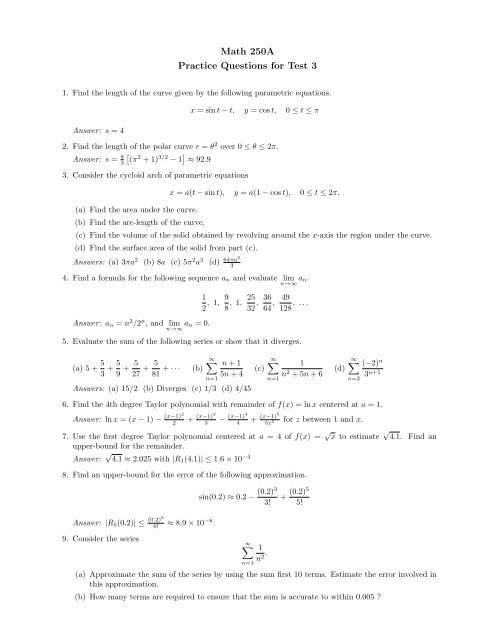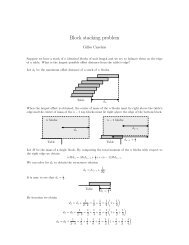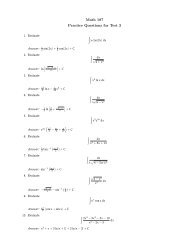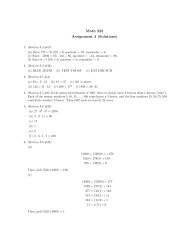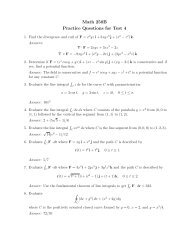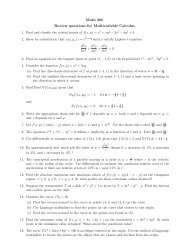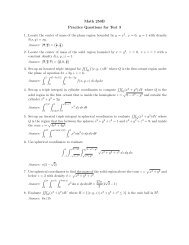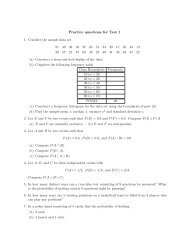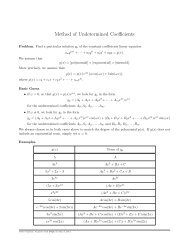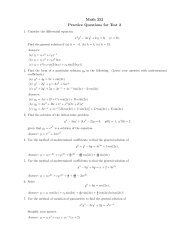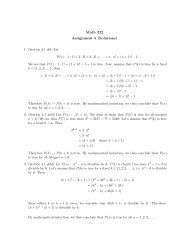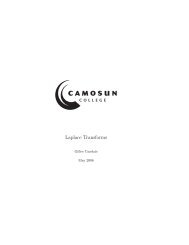Math 250A Practice Questions for Test 3
Math 250A Practice Questions for Test 3
Math 250A Practice Questions for Test 3
- No tags were found...
Create successful ePaper yourself
Turn your PDF publications into a flip-book with our unique Google optimized e-Paper software.
<strong>Math</strong> <strong>250A</strong><strong>Practice</strong> <strong>Questions</strong> <strong>for</strong> <strong>Test</strong> 31. Find the length of the curve given by the following parametric equations.Answer: s = 4x = sin t − t, y = cos t, 0 ≤ t ≤ π2. Find the length of the polar curve r = θ 2 over 0 ≤ θ ≤ 2π.[Answer: s = 8 3 (π 2 + 1) 3/2 − 1 ] ≈ 92.93. Consider the cycloid arch of parametric equations(a) Find the area under the curve.(b) Find the arc-length of the curve.x = a(t − sin t), y = a(1 − cos t), 0 ≤ t ≤ 2π.(c) Find the volume of the solid obtained by revolving around the x-axis the region under the curve.(d) Find the surface area of the solid from part (c).Answers: (a) 3πa 2 (b) 8a (c) 5π 2 a 3 (d) 64πa234. Find a <strong>for</strong>mula <strong>for</strong> the following sequence a n and evaluate limn→∞ a n.Answer: a n = n 2 /2 n , and limn→∞ a n = 0.12 , 1, 98 , 1, 2532 , 3664 , 49128 , . . .5. Evaluate the sum of the following series or show that it diverges.(a) 5 + 5 3 + 5 9 + 527 + 5 ∞ 81 + · · · (b) ∑ n + 15n + 4n=1Answers: (a) 15/2 (b) Diverges (c) 1/3 (d) 4/45(c)∞∑n=11n 2 + 5n + 6(d)∞∑n=2(−2) n3 n+16. Find the 4th degree Taylor polynomial with remainder of f(x) = ln x centered at a = 1.Answer: ln x = (x − 1) − (x−1)22+ (x−1)33− (x−1)44+ (x−1)55z 5 <strong>for</strong> z between 1 and x.7. Use the first degree Taylor polynomial centered at a = 4 of f(x) = √ x to estimate √ 4.1. Find anupper-bound <strong>for</strong> the remainder.Answer: √ 4.1 ≈ 2.025 with |R 1 (4.1)| ≤ 1.6 × 10 −48. Find an upper-bound <strong>for</strong> the error of the following approximation.Answer: |R 5 (0.2)| ≤ (0.2)66!≈ 8.9 × 10 −89. Consider the seriessin(0.2) ≈ 0.2 − (0.2)33!∞∑n=11n 2 .+ (0.2)55!(a) Approximate the sum of the series by using the sum first 10 terms. Estimate the error involved inthis approximation.(b) How many terms are required to ensure that the sum is accurate to within 0.005 ?
<strong>Math</strong> <strong>250A</strong> <strong>Practice</strong> <strong>Questions</strong> <strong>for</strong> <strong>Test</strong> 3 Page 2 of 2Answers: (a) S ≈ 1.55 with 0 < R 10 ≤ 0.1 (b) 200 terms10. Estimate the sum of the seriescorrect to three decimals place.∞∑ (−1) nn=01Answer:0! − 1 1! + 1 2! − · · · + 1 6!≈ 0.368, and we have |error| ≤ 0.0002. The exact value of this series ise −1 .11. <strong>Test</strong> <strong>for</strong> convergence or divergence the following series. Identify the test used and make sure all appropriatehypotheses are satisfied.(a)(e)(i)∞∑n=1∞∑n=1∞∑n=1ne −n2(b)∞∑n=1( ) n 3n(f)4n + 1e −n2(j)∞∑n=1√ n + 34n 2 + 1∞∑n=13n + 25n 2 + 1(c)(−1) n+1 n!1 · 3 · 5 · · · (2n − 1)∞∑n=1(g)n!cos ( )1n∞∑n=2(k)1n ln n∞∑n=1(d)cos(n)n 3∞∑n=0(h)(−1) n√ n + 1Answers:(a) Converges. Use the integral test.(b) Converges. Use limit comparison with a p-series (p = 3/2).(c) Diverges. Use the nth term test.(d) Converges. Use the alternating series test.(e) Converges. Use the root test.(f) Diverges. Use limit comparison with the harmonic series.(g) Diverges. Use the integral test.(h) Converges. Use the ratio test.(i) Converges. Use direct comparion with a geometric series with r = e −1 .(j) Converges. Use the ratio test.(k) Converges absolutely. Use direct comparison with a p-series. (p = 3).(l) Diverges. Divergent geometric series.12. Find the interval of convergence ofAnswer: [−1, 3], i.e., −1 ≤ x ≤ 3.∞∑n=1(x − 1) nn 2 · 2 n .13. Find the first four nonzero terms of the Maclaurin series of the following.(a) xe −2x (b) cos 2 x (c) sin x cos x (d) e −x cos x (e) 3√ 1 + x 2Answers:(a) x − 2 x 2 + 2 x 3 − 4 3 x4 + · · ·(b) 1 − x 2 + 1 3 x4 − 2 45 x6 + · · ·(c) x − 2 3 x3 + 2 15 x5 − 4315 x7 + · · ·(d) 1 − x + 1 3 x3 − 1 6 x4 + · · ·(e) 1 + 1 3 x2 − 1 9 x4 + 5 81 x6 + · · ·14. Use three nonzero terms of an appropriate series to approximate the following integrals. Find an upperbound<strong>for</strong> the error.∫ 1∫ 0.5 √(a) cos(x 2 3) dx (b) 1 + x2 dx0Answers: (a) 0.9046 with |error| < 10 −40∞∑n=1(l)1n!∞∑n=03 n+1e n(b) 0.51319 with |error| < 6.9 × 10 −5


